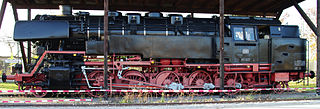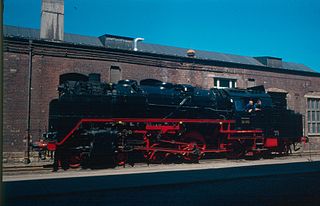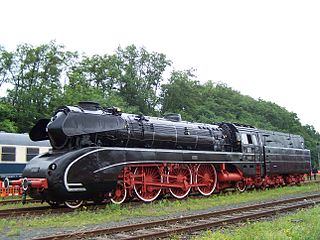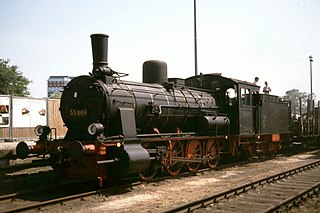
The DRG Class 86 was a standard goods train tank locomotive with the Deutsche Reichsbahn-Gesellschaft. It was intended for duties on branch lines and was delivered by almost all the locomotive building firms working for the Reichsbahn. From 1942 it was built in a simplified version as a 'transitional war locomotive'. The most obvious changes were the omission of the second side windows in the cab and the solid disc carrying wheels.

The Class 44 was a ten-coupled, heavy goods train steam locomotive built for the Deutsche Reichsbahn as a standard steam engine class (Einheitsdampflokomotive). Its sub-class was G 56.20 and it had triple cylinders. It was intended for hauling goods trains of up to 1,200 tonnes on the routes through Germany's hilly regions (Mittelgebirge) and up to 600 tonnes on steep inclines. They were numbered 44 001-44 1989.

The Class 85 was a German goods train tank engine and standard locomotive (Einheitslok) with the Deutsche Reichsbahn.

The Class 62 engines were standard passenger train tank locomotives of Germany's Deutsche Reichsbahn-Gesellschaft (DRG).

The locomotives of the German DRG Class 81 were standard (Einheitsdampflokomotiven) goods train tank locomotives with the Deutsche Reichsbahn-Gesellschaft (DRG).

The DRG Class 89.0 was a goods train tank engine of standard design built for the Deutsche Reichsbahn (DRG).

The German Class 03.10 engines were standard steam locomotives (Einheitsdampflokomotiven) belonging to the Deutsche Reichsbahn and designed for hauling express trains.

The Prussian T 18 was the last class of tank locomotives developed for the Prussian state railways. They were originally intended for services on the island of Rügen as replacements for Class T 12 and T 10 engines. They emerged when a class of locomotive was conceived in 1912 that was to handle express and passenger trains in border areas or in shuttle services on short routes. A tank engine design with symmetrical running gear was envisaged because, unlike a tender locomotive, it could run equally fast forwards and backwards and could be operated on return journeys without having to be turned on a turntable. Its power and top speed were to be the same as those of the P 8. Robert Garbe designed this 4-6-4 (2′C2′) tank locomotive for 100 km/h with a 17-ton axle load and contracted the Vulkan Werke in Stettin to build it. It was given the designation T 18.

Between 1934 and 1941 the Deutsche Reichsbahn (DRG) converted a total of 691 former Prussian-built Class 55.25–56 steam locomotives; the result was the DRG Class 56.2–8. The carrying axle enabled higher speeds and the engine could even be used as a passenger train locomotive. In addition the average axle load was lower, so that these locomotives could also be used on branch lines. The conversion entailed moving the boiler forward and raising it somewhat. The vehicles were given operating numbers between 56 201 and 56 891, although the numbering was not continuous.

The Prussian G 12 is a 1'E 2-10-0 goods train locomotive built for the Prussian state railways.

The Prussian G 10 was a German goods train, steam locomotive, whose design was based on a combination of the running and valve gear from the Prussian T 16 and the boiler from the Prussian P 8. In developing the G 10, however, the T 16 running gear with side play on the first and fifth axles was modified. The T 16 was also subsequently built with this modified configuration and called the Prussian T 16.1. The G 10 was intended for heavy goods train duties on main lines, but as a result of its low axle load it could be employed more flexibly than its equally powerful cousin, the Prussian G 8.1. The G 10 was occasionally even used in passenger train service.

The steam locomotives of Class 23 were German passenger train locomotives developed in the 1950s for the Deutsche Bundesbahn. They had a 2-6-2 wheel arrangement and were equipped with Class 2'2' T 31 tenders. They were designed to replace the once ubiquitous Prussian P 8 engines that had been built between 1908 and 1924 and, in their day, were the most numerous post-war replacement class.

The steam locomotives of DB Class 10 were express locomotives with the Deutsche Bundesbahn in Germany after the Second World War. They were nicknamed 'Black Swans' as a result of their elegant shape.

The DB Class 82 was a goods train tank locomotive with the Deutsche Bundesbahn in Germany, that was built in the period after the Second World War and was intended for shunting and normal rail services. They were to replace the ten-coupled state railway (Länderbahn) engines and also the accident-prone Class 87 DRG Einheitslok.

The DR Class 65.10 was a four-coupled passenger train tank engine operated by the East German Deutsche Reichsbahn (DR) for heavy suburban and commuter services.

The Prussian T 16.1 locomotives were built for the Prussian state railways as goods train tank locomotives about the time of the First World War. Six examples were also procured by the Imperial Railways in Alsace-Lorraine.

The Prussian Class G 7.1 engines of the Prussian state railways were German eight-coupled, goods train, steam locomotives.
The Prussian T 9 was a class of German steam locomotive which included several types of tank engine, all with six coupled wheels and two carrying wheels operated by the Prussian state railways.
The Prussian G 8.2 class of locomotives actually incorporated two different locomotive types: one was the Prussian/Oldenburg G 8.2, for which the Deutsche Reichsbahn subsequently issued follow-on orders; the other was the G 8.2 of the Lübeck-Büchen Railway.

The Prussian T 8 were six-coupled superheated goods tank locomotives of the Prussian state railways. They were originally intended for suburban passenger service in Berlin, and for use on branch lines. Due to their poor running qualities, they were demoted to shunting and short-distance goods train service.



















